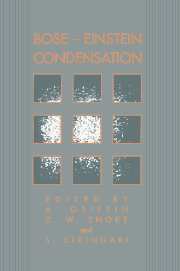Book contents
- Frontmatter
- Contents
- Preface
- Preface to paperback edition
- 1 Introduction: Unifying Themes of Bose–Einstein Condensation
- Part one Review Papers
- 2 Some Comments on Bose–Einstein Condensation
- 3 Bose–Einstein Condensation and Superfluidity
- 4 Bose-Einstein Condensation in Liquid Helium
- 5 Sum Rules and Bose–Einstein Condensation
- 6 Dilute-Degenerate Gases
- 7 Prospects for Bose–Einstein Condensation in Magnetically Trapped Atomic Hydrogen
- 8 Spin-Polarized Hydrogen: Prospects for Bose–Einstein Condensation and Two-Dimensional Superfluidity
- 9 Laser Cooling and Trapping of Neutral Atoms
- 10 Kinetics of Bose–Einstein Condensate Formation in an Interacting Bose Gas
- 11 Condensate Formation in a Bose Gas
- 12 Macroscopic Coherent States of Excitons in Semiconductors
- 13 Bose–Einstein Condensation of a Nearly Ideal Gas: Excitons in Cu2O
- 14 Bose–Einstein Condensation of Excitonic Particles in Semiconductors
- 15 Crossover from BCS Theory to Bose–Einstein Condensation
- 16 Bose–Einstein Condensation of Bipolarons in High-Tc Superconductors
- 17 The Bosonization Method in Nuclear Physics
- 18 Kaon Condensation in Dense Matter
- 19 Broken Gauge Symmetry in a Bose Condensate
- Part two Brief Reports
- Appendix. BEC 93 Participant List
- Index
14 - Bose–Einstein Condensation of Excitonic Particles in Semiconductors
Published online by Cambridge University Press: 15 December 2009
- Frontmatter
- Contents
- Preface
- Preface to paperback edition
- 1 Introduction: Unifying Themes of Bose–Einstein Condensation
- Part one Review Papers
- 2 Some Comments on Bose–Einstein Condensation
- 3 Bose–Einstein Condensation and Superfluidity
- 4 Bose-Einstein Condensation in Liquid Helium
- 5 Sum Rules and Bose–Einstein Condensation
- 6 Dilute-Degenerate Gases
- 7 Prospects for Bose–Einstein Condensation in Magnetically Trapped Atomic Hydrogen
- 8 Spin-Polarized Hydrogen: Prospects for Bose–Einstein Condensation and Two-Dimensional Superfluidity
- 9 Laser Cooling and Trapping of Neutral Atoms
- 10 Kinetics of Bose–Einstein Condensate Formation in an Interacting Bose Gas
- 11 Condensate Formation in a Bose Gas
- 12 Macroscopic Coherent States of Excitons in Semiconductors
- 13 Bose–Einstein Condensation of a Nearly Ideal Gas: Excitons in Cu2O
- 14 Bose–Einstein Condensation of Excitonic Particles in Semiconductors
- 15 Crossover from BCS Theory to Bose–Einstein Condensation
- 16 Bose–Einstein Condensation of Bipolarons in High-Tc Superconductors
- 17 The Bosonization Method in Nuclear Physics
- 18 Kaon Condensation in Dense Matter
- 19 Broken Gauge Symmetry in a Bose Condensate
- Part two Brief Reports
- Appendix. BEC 93 Participant List
- Index
Summary
Abstract
The case of excitons as candidates for Bose–Einstein condensation is discussed, and experimental results in CuCl and Cu2O are presented. In CuCl, spectral analysis of the luminescence from biexcitons as a function of their density reveals a gradual evolution from classical statistics towards a quantum degenerate regime. The appearance of a sharp emission line below a critical temperature and above a critical density is attributed to the presence of a laser-induced Bose–Einstein condensate of excitonic molecules. This interpretation is supported by pump-probe experiments which show that additional particles injected in the presence of a biexciton condensate are drawn into it.
In Cu2O, free exciton luminescence spectral analysis of ortho- and paraexcitons reveals a gradual evolution from a classical to a Bose quantum degenerate regime with increasing particle densities. Orthoexciton densities close to the critical density for condensation are obtained at high incoherent excitation. Under similar pumping, paraexciton densities exceeding the critical value are inferred from luminescence intensity ratios. Anomalous transport properties of paraexcitons, such as ballistic propagation over macroscopic distances and formation of soliton-like excitonic packets are discussed as evidence for excitonic superfluidity.
Introduction
Excitons
The lowest electronically excited state of a non-metallic crystal corresponds to the promotion of one electron from the top of the highest fully occupied valence band to the bottom of the next empty conduction band. A correct evaluation of the required energy must include the Coulomb correlation between the promoted electron and all other electrons left behind in the valence band.
- Type
- Chapter
- Information
- Bose-Einstein Condensation , pp. 330 - 354Publisher: Cambridge University PressPrint publication year: 1995
- 3
- Cited by

